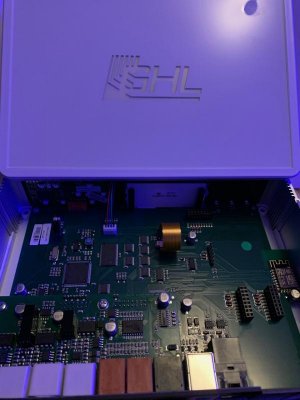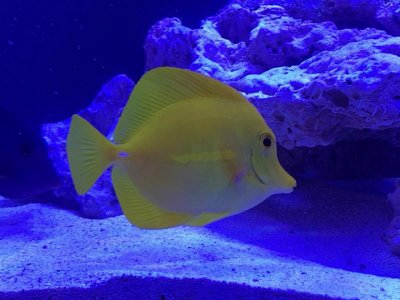I've been into this amazing hobby for probably 6 years. It started as something for my son and he rapidly lost interest but I was hooked (excuse the pun).
A couple of tanks later and I've currently got a Reefer 350.
I eventually got it to the point where SPS were visibly growing. I then decided to 'fix' the numbers, dealing with a phosphate 'issue' that turned out to be more of a test kit issue. I eventually realised I should trust my eyes more than anything else and things started to settle down and corals started to grow again. I went through a horrible GHA phase but that passed once I got phosphate under control, although it was replaced with Cyano after getting the phosphate too much under control (Hana checker reporting far more phosphate than there actually was). Eventually things settled down and it looked like things were starting to go well...
It's now an absolute mess, having been completely taken over by Aiptasia. Initially a Matted Filefish was taking care of them but then he decided he much preferred the normal food. I tried various methods of dealing with them but the population exploded and are now beyond being dealt with. The only solution I can see is to remove everything from the tank and start again, putting into practice the lessons I've learned along the way.
So, a D-D 1500S is on it's way and should be with me in a few weeks!
In all honesty, I wanted a bigger tank anyway.
I'll be starting the tank with fully cycled live rock and some Dr Tims to help it out a bit and will hopefully have a decent filter from the beginning, as my stock has to be transferred immediately. I'll be assisted in this transfer by the ever-helpful Dan at the Coral Cabin, who is reasonably local to me. His shop has come on leaps and bounds and I've always been happy with the service he provides. Well worth a visit. Some live sand will be used - I'm not sure it's actually of any help but... why not.
I'll be interested in any tips and suggestions that the community can provide along the way.
Stock to be transferred is:
- Pair of Picasso Clownfish (had them for most of my time in the hobby).
- Powder Blue Tang (fat and healthy and I've had him for a few years, but he looks like he would appreciate some more space).
- Purple Tang (again, I've had him for a few years).
- Yellow Tang (had him even longer than the others, all of which get along well).
- Cleaner Wrasse (rather large and the most aggressive fish in the tank, so he will be sumped for a little while).
- Three Scribbled Anthias (a decent size these days but I don't think they look particularly healthy and they are certainly not as colourful or vibrant as they once were - I'm not sure if I want to keep them).
- Yellow Tail Tamarind Wrasse (a good size now and always active - lovely fish).
I'd like to get a couple more Wrasse in due course, hence the Cleaner Wrasse going in the sump - he cost me a gorgeous Diamond Tail Wrasse (a replacement for the previous one that jumped after a tank sitter decided to take the jump guard off and not put it back on correctly) and I'd like another.
Current equipment to be retained:
- Deltec SC1456 skimmer.
- Schego 300W heater (I have a second that I can also use).
- Two Gyre 250 pumps.
- Jecod 6000 DC return pump.
- D-D 39W UV.
- Clarisea filter.
- Radion Gen 4 XR30s with diffusers.
- Tunze Oslomator ATO.
The current tank is running on an Apex Classic. I've also got a Dastaco XtremA A1 with a light sensor that is somewhat redundant as I now have zero corals and will not have some for a bit and a Pacific Sun Kore 5th doser.
I'm contemplating selling the Apex, Pacific Sun and Dastaco and going with a GHL Profilux P4 with a KH Director and a couple of Slave Doser 2.1 units. I fancy trying the ATI Essentials Pro products.
For nutrient control, I have an ALR1 or I can carbon dose. I also have a Deltec FR509 media reactor available. I'd like to use a natural method but people's results seem rather hit or miss with the ALR? I've had success with carbon dosing but it does seem easy for the phosphate to get out of balance. I'm keen to keep things as simple and low-maintenance as possible - I've found that the more I try to do (chasing numbers, for example) then the worse things can get! I'm hoping to start things off in the right way, with the lessons I've learned along the way, and just keep doing that without messing around...
I'd welcome any thoughts on this, anyone who has used the ATI products and their thoughts on them. General ideas about current thoughts on systems, etc. I'll hopefully keep track of development here and report the good and the bad along the way, as I've found it very helpful to learn from other tank posts over the years.
So, let me have your thoughts on this while I'm still at the planning stages and wish me luck!
PS: I started this thread a short time ago on another forum but decided to have it on this forum as well, so I'll get it up to speed and then update as I go along.
A couple of tanks later and I've currently got a Reefer 350.
I eventually got it to the point where SPS were visibly growing. I then decided to 'fix' the numbers, dealing with a phosphate 'issue' that turned out to be more of a test kit issue. I eventually realised I should trust my eyes more than anything else and things started to settle down and corals started to grow again. I went through a horrible GHA phase but that passed once I got phosphate under control, although it was replaced with Cyano after getting the phosphate too much under control (Hana checker reporting far more phosphate than there actually was). Eventually things settled down and it looked like things were starting to go well...
It's now an absolute mess, having been completely taken over by Aiptasia. Initially a Matted Filefish was taking care of them but then he decided he much preferred the normal food. I tried various methods of dealing with them but the population exploded and are now beyond being dealt with. The only solution I can see is to remove everything from the tank and start again, putting into practice the lessons I've learned along the way.
So, a D-D 1500S is on it's way and should be with me in a few weeks!
In all honesty, I wanted a bigger tank anyway.
I'll be starting the tank with fully cycled live rock and some Dr Tims to help it out a bit and will hopefully have a decent filter from the beginning, as my stock has to be transferred immediately. I'll be assisted in this transfer by the ever-helpful Dan at the Coral Cabin, who is reasonably local to me. His shop has come on leaps and bounds and I've always been happy with the service he provides. Well worth a visit. Some live sand will be used - I'm not sure it's actually of any help but... why not.
I'll be interested in any tips and suggestions that the community can provide along the way.
Stock to be transferred is:
- Pair of Picasso Clownfish (had them for most of my time in the hobby).
- Powder Blue Tang (fat and healthy and I've had him for a few years, but he looks like he would appreciate some more space).
- Purple Tang (again, I've had him for a few years).
- Yellow Tang (had him even longer than the others, all of which get along well).
- Cleaner Wrasse (rather large and the most aggressive fish in the tank, so he will be sumped for a little while).
- Three Scribbled Anthias (a decent size these days but I don't think they look particularly healthy and they are certainly not as colourful or vibrant as they once were - I'm not sure if I want to keep them).
- Yellow Tail Tamarind Wrasse (a good size now and always active - lovely fish).
I'd like to get a couple more Wrasse in due course, hence the Cleaner Wrasse going in the sump - he cost me a gorgeous Diamond Tail Wrasse (a replacement for the previous one that jumped after a tank sitter decided to take the jump guard off and not put it back on correctly) and I'd like another.
Current equipment to be retained:
- Deltec SC1456 skimmer.
- Schego 300W heater (I have a second that I can also use).
- Two Gyre 250 pumps.
- Jecod 6000 DC return pump.
- D-D 39W UV.
- Clarisea filter.
- Radion Gen 4 XR30s with diffusers.
- Tunze Oslomator ATO.
The current tank is running on an Apex Classic. I've also got a Dastaco XtremA A1 with a light sensor that is somewhat redundant as I now have zero corals and will not have some for a bit and a Pacific Sun Kore 5th doser.
I'm contemplating selling the Apex, Pacific Sun and Dastaco and going with a GHL Profilux P4 with a KH Director and a couple of Slave Doser 2.1 units. I fancy trying the ATI Essentials Pro products.
For nutrient control, I have an ALR1 or I can carbon dose. I also have a Deltec FR509 media reactor available. I'd like to use a natural method but people's results seem rather hit or miss with the ALR? I've had success with carbon dosing but it does seem easy for the phosphate to get out of balance. I'm keen to keep things as simple and low-maintenance as possible - I've found that the more I try to do (chasing numbers, for example) then the worse things can get! I'm hoping to start things off in the right way, with the lessons I've learned along the way, and just keep doing that without messing around...
I'd welcome any thoughts on this, anyone who has used the ATI products and their thoughts on them. General ideas about current thoughts on systems, etc. I'll hopefully keep track of development here and report the good and the bad along the way, as I've found it very helpful to learn from other tank posts over the years.
So, let me have your thoughts on this while I'm still at the planning stages and wish me luck!
PS: I started this thread a short time ago on another forum but decided to have it on this forum as well, so I'll get it up to speed and then update as I go along.


















